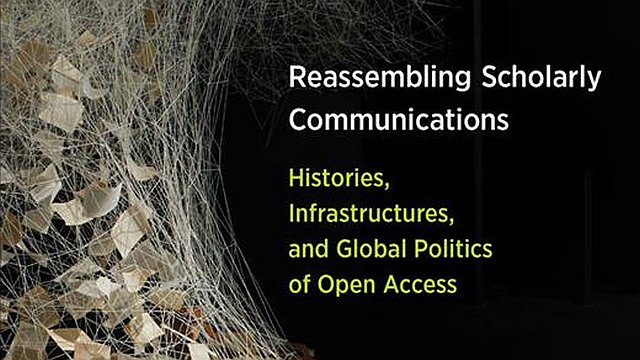
Open access to scholarly knowledge in the digital era (chapter 5.5): The pasts, presents, and futures of SciELO
This article is chapter 5.5 in section 5 of a series of articles summarising the book Reassembling Scholarly Communications: Histories, Infrastructures, and Global Politics of Open Access.
In the final chapter of the infrastructures and platforms section, Abel Packer details the history, present, and future of the Scientific Electronic Library Online (SciELO) platform in South America. As the Director of the SciELO project, Packer gives an informed perspective on one of the longest-standing and most widespread open-access platforms on the planet. As the chapter shows, South American countries have pioneered the way in open access and achieved much more than their northern counterparts.
SciELO is a not-for-profit network of over 1,000 journals that emphasizes the academic, cultural, and social relevance of scholarly communications. The SciELO Network is dispersed, with most institutions publishing fewer than two indexed journals. When SciELO was founded, most of these journals were barely breaking even. There were only a limited number of subscriptions to their print editions, their presence was known only to small and insular research communities, and they held low or no international visibility. In part, SciELO was founded to mitigate this situation through the adoption of digital open-access publishing, indexing, and dissemination, at scale.
Packer reports that in 2018, SciELO celebrated its twentieth birthday by hosting a public forum with over 700 participants. The network also revisited the future goals for the platform and agreed to update the “common action lines” in order to advance journals’ professionalization, internationalization, and sustainability.
Building a common publishing model
SciELO is a program based on international cooperation, which aggregates journal publications into a single location. It strives to improve the capacities and qualifications of journals while respecting their independence.
The publishing model was initially planned over a year pilot, and consisted of a partnership between the São Paulo Research Foundation (FAPESP) and the Latin American and Caribbean Center on Health Sciences Information of the Pan American Health Organization at the regional office of the World Health Organization (BIREME/PAHO/WHO). The Brazilian Research Council was already running a program to support journals published by institutions from the State of São Paulo, but it lacked bibliometric indicators. SciELO was designed to improve this situation.
BIREME’s expertise in scientific information management was derived from its regional technical cooperation through the Latin American and Caribbean network of health science libraries, and from its development of the Virtual Health Library (VHL) platform for web-based international cooperation to maximize access to health science information. SciELO was initially conceived by BIREME as an associated network of the VHL.
From these common goals and a workshop held in March 1998 in São Paulo, SciELO was born, and the first article describing the SciELO publishing model was published in Portuguese and translated and published in Spanish. After its launch in Brazil and Chile, SciELO expanded rapidly, and in 2000 it launched a public health collection. The secretariat for the network was moved to Brazil, and BIREME restricted its operation to the coordination of SciELO Public Health.
As part of its expandion, SciELO developed a set of simple protocols for establishing new collections, Each new collection must be led and funded by a nationally recognized research and technology organization, beginning with a three-month “pilot collection” of three to five journals operating in an intranet setting. This is followed by an open web operation under the label of an “in-development collection” for approximately six to eight months. Finally, when all requirements are in place, the collection moves to certified status.
Documenting the evolution of the SciELO program and network
The growth of the SciELO Network can be seen in the distributions of the annual total number of journals and documents indexed by the network of national collections. The SciELO Network has reached a stable level of 51,000 newly published documents per year, 90 percent of which are articles and reviews.
SciELO’s collections span a variety of subjects and editorial policies. There is no predefined pattern, priority, or privilege with respect to the composition of the collections, and multilingualism is also an inherent characteristic. Brazil is responsible for about 40 percent of the contents, followed by Colombia, Mexico, and Chile, and about 12 percent of the documents are not identified as communicating research, which is the case with opinion editorials, obituaries, and so forth.
Health sciences, human sciences, and applied social sciences comprise 67 percent of the articles, with the presence of other disciplinary spaces limited. Exceptions include agricultural topics, covering 17 percent of articles from Brazil, and biological sciences have a prominent profile in Costa Rica and South Africa. Except for South Africa’s and Brazil’s collections, non-English articles prevail in more than two-thirds of the articles in 12 collections and in more than 90 percent of seven collections. With respect to the proportion of foreign authorship, Brazil and Cuba publish predominantly national authors, while Chile and Costa Rica have a foreign author on more than 50 percent of their articles.
SciELO, open access, and technology
The SciELO model and platform have brought technological innovations to the production of its included journals. The most important of these was the pioneering adoption of open access as inherent to online publishing, which happened four years before the Budapest Declaration. Three main conditions made this possible.
First, SciELO’s successful implementation as a pilot project embraced the innate characteristics of the web and developed a common methodological and technological solution to index, publish, and disseminate journals online with minimal or no costs for the institutions responsible and with no interference with the paper-based publication. Second, most of the quality journals targeted by SciELO were nonprofit with subscription fees intended to recover only the costs of publication. However, journals with many subscriptions, particularly in the social sciences, resisted open access and took a long time to embrace this model. Third, as stated before, the institutional authority given by FAPESP and BIREME was essential.
SciELO supplemented the role played by indexes in the US, which were not properly covering the journals of Brazil and many other countries. The emergence of SciELO as an international index of quality journals represented a breakthrough for national scholarly publishing, overcoming existing restrictions, and the lack of information and capacity faced by public and institutional policies to govern the advancement of journals.
SciELO took open access as an inherent condition of a web publishing model, and adopted the Creative Commons Attribution License as the standard license to promote universal nonrestricted, continued access to updated, qualified, and relevant scientific information and knowledge. SciELO’s dissemination power is based on its compliance with bibliographic standards, which were progressively applied to the entire full text using XML semantic markup elements. Since 2015, SciELO has implemented the Journal Article Tag Suite (JATS) standard through the SciELO Publishing Schema.
The most important challenge SciELO and similar journals face, however, lies in governmental and institutional policies that have prioritized a simplistic use of crude metrics, such as the journal impact factor, as proxies for the value of research.
The collective building of the present and future of SciELO
SciELO’s foundations have remained essentially constant from its inception. Its modus operandi is to maximize inclusion, academic autonomy, and widespread development of capacities and infrastructures as the basis for autonomous national policies on scholarly communication with global interoperability.
SciELO’s development is conducted with no formal bilateral or multilateral signed documents at the level of the network of collections and within national collections. The SciELO Network and its common virtual space are voluntary, and collectively built and developed by both the national collections and their individual journals. They are driven by three main agreed lines of action covering the next five years. The first line of action is professionalization. The second, internationalization line seeks an appropriate balance of the presence of national- and foreign-qualified researchers as editors, peer reviewers, and authors, as well as publication in the English language in order to maximize the proactive presence in the international flow of scientific information. The third line of action seeks the strengthening of operational and financial sustainability of the journals as a commitment to the research community.
In the future, SciELO journals will transition to open science as a fully open workflow, with the three lines of action for SciELO journals enriched by the inclusion of the publication of preprints and the continuous publication of individual manuscripts as soon as they are approved.
These lines of action, embedded within the open-science practices listed above, project a renewed future for the SciELO Program, with journals focusing their role progressively on the validation of research. It is expected that the comprehensive nature of open science will contribute to enhancing the evaluation of SciELO and similar journals by national research agencies and institutions beyond the simplistic adoption of rankings.
In closing his chapter, Packer states that the richness of open science and the related complexities do represent threats to journals, but they open also new opportunities to enhance their role in the future of scholarly communications: an approach to which the SciELO program is committed.
Next part (section 6): Global communities.
Article source: This article is an edited summary of Chapter 211 of the book Reassembling scholarly communications: Histories, infrastructures, and global politics of Open Access2 which has been published by MIT Press under a CC BY 4.0 Creative Commons license.
Acknowledgements: This summary has been prepared with the assistance of Wordtune Read.
Article license: This article is published under a CC BY 4.0 Creative Commons license.
References:
- Packer, A. L. (2020). The Pasts, Presents, and Futures of SciELO. In Eve, M. P., & Gray, J. (Eds.) Reassembling scholarly communications: Histories, infrastructures, and global politics of Open Access. MIT Press. ↩
- Eve, M. P., & Gray, J. (Eds.) (2020). Reassembling scholarly communications: Histories, infrastructures, and global politics of Open Access. MIT Press. ↩






